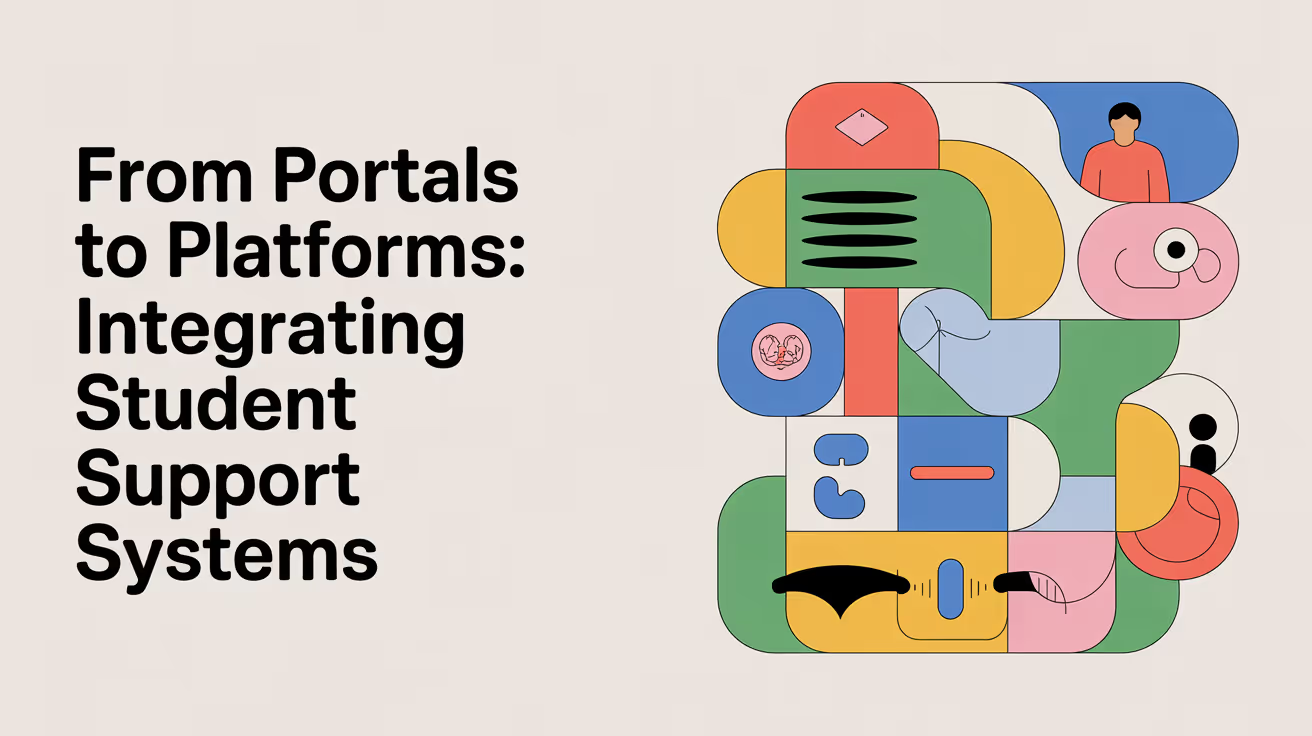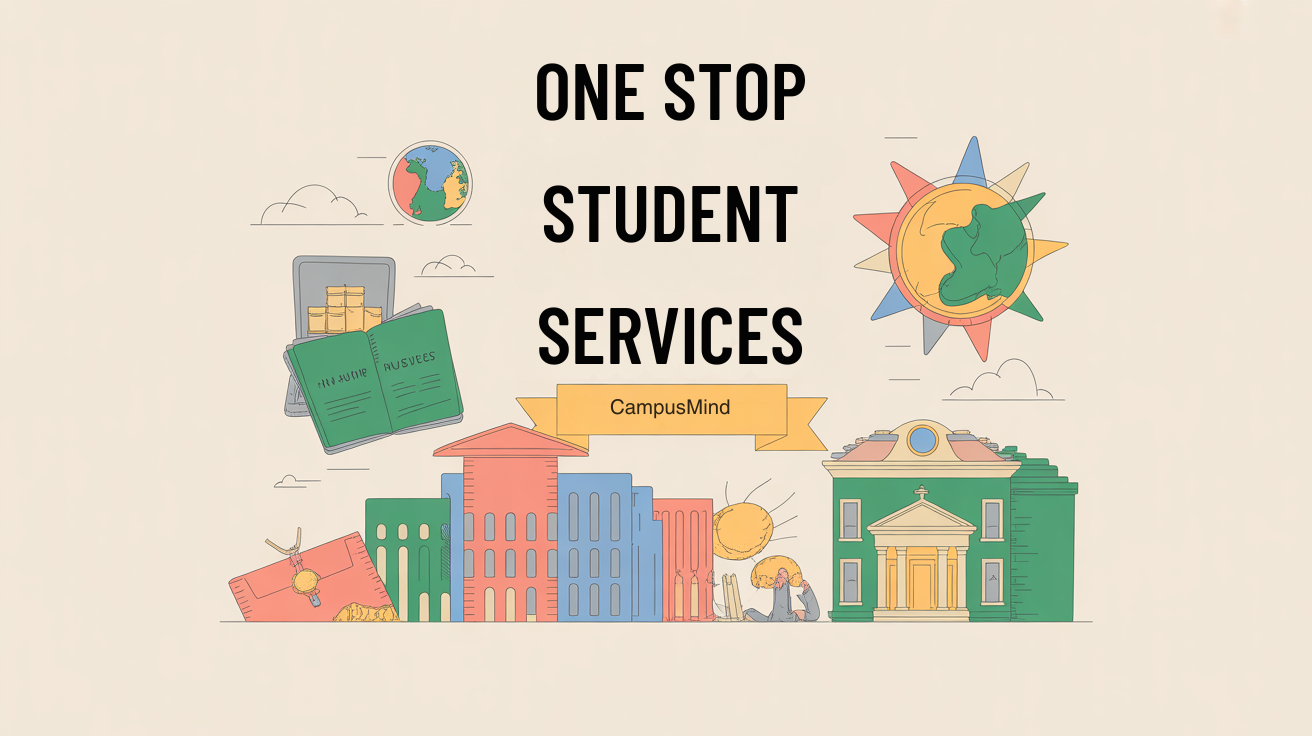Featured Snippet
Integrated support systems consolidate fragmented student data across advising, academics, wellness, and basic needs into unified platforms. These systems enable real-time interventions by providing a 360-degree student view, helping institutions identify at-risk students earlier and improve persistence rates through coordinated, data-driven support.
Introduction - Integrated Student Support Systems
The average college student navigates a maze of disconnected systems—separate portals for course registration, financial aid, counseling appointments, academic advising, and basic needs assistance. For campus leadership teams focused on retention, this fragmentation creates dangerous blind spots that prevent timely support when students need it most.
Nearly 84 percent of first-year students who enrolled in fall 2023 persisted to the spring term, though 14 percent left higher education entirely, according to National Student Clearinghouse Research Center data. With first spring persistence data now available, institutions have earlier indicators to identify and support students who may be at risk of stopping out. But capturing these early warning signs requires something most institutions lack: integrated support systems that break down data silos.
Why Siloed Systems Block Student Success
Digital fragmentation causes frustration to everyone, makes institutions more vulnerable to cyber attack, and increasingly holds back progress on key institutional strategic agendas in education and student support. When advising systems don't communicate with learning management systems, and mental health services operate independently from academic records, crucial patterns go unnoticed.
Silos hinder collaboration, impede information sharing, and create inefficiencies within institutions, leading to duplicated efforts, limited interdisciplinary collaboration, and fragmented educational experiences for students. An advisor might not know a student missed three consecutive classes. Counseling center staff may be unaware that the same student just lost their housing. Basic needs coordinators might not realize financial holds are preventing course registration.
These information gaps have real consequences. Part-time students faced significant risk, with nearly one-third not returning for the spring semester and almost half failing to persist into their second fall term. Many of these students show warning signs across multiple systems—but no single staff member sees the complete picture.
The 360-Degree Student View
Integrated support systems consolidate data from disparate sources into a unified platform that provides what campus leaders call a "360-degree student view." Rather than forcing staff to log into five separate portals, integration creates a central hub where engagement data, academic performance, wellness check-ins, and resource utilization appear together in real time.
To achieve their student success goals, institutions must modernize and centralize their systems, from data collection to data processing, management and analysis, to ensure that administrators, faculty, and staff have a unified, reliable view of information upon which they can make informed decisions.
This holistic visibility enables proactive rather than reactive support. When a student's attendance drops, their advising appointments are missed, and they've stopped engaging with campus resources, an integrated system can trigger early alerts that prompt coordinated intervention from multiple support teams.
Cloud-based SIS platforms account for 85 percent of new product launches, replacing outdated on-premise models, and data-driven student success tools have increased by 65 percent. The shift toward cloud-based integration reflects growing recognition that legacy systems cannot keep pace with modern student support needs.
Quick Wins: Where to Start Integration
Campus leaders don't need to overhaul every system simultaneously. Strategic integration can start with high-impact connections:
LMS and Advising Integration: Connect learning management system data with advising platforms so advisors see real-time attendance, assignment completion, and grade trends during student meetings. This simple integration transforms advising conversations from retrospective ("How did last semester go?") to proactive ("I see you're struggling in calculus—let's connect you with tutoring this week").
Basic Needs and Financial Aid: Link basic needs requests with financial aid status. Students facing food or housing insecurity often have unresolved financial aid issues that, once addressed, can alleviate the underlying crisis.
Wellness and Academic Performance: Create data-sharing protocols between counseling services and academic affairs. While respecting student privacy, aggregate wellness utilization data can help identify cohorts needing additional support without compromising individual confidentiality.
Modern systems provide personalized academic advising, centralized degree planning, and accessible financial aid support, unlocking the full power of data to make smarter, faster decisions.
Privacy, FERPA, and Student Trust
Integration raises legitimate privacy concerns that institutions must address thoughtfully. While the general rule under FERPA is that personally identifiable information from education records cannot be disclosed without written consent, FERPA includes exceptions that permit data sharing under certain conditions.
Educational authorities can participate in integrated data systems while ensuring student privacy in compliance with FERPA. Best practices include:
Data Governance Frameworks: Establish clear policies defining who can access what information, for what purposes, and under what circumstances. Without a defined data governance framework, institutions struggle to establish policies for data sharing, security, and standardization.
Role-Based Access Controls: Not everyone needs to see everything. Advisors require different data access than faculty, who need different access than basic needs coordinators. Properly configured systems grant minimum necessary access while enabling coordination.
Transparency with Students: Explain how data integration improves support. Research shows students are more willing to share information when they understand how it directly benefits their success. Position integrated systems as student-centered tools, not surveillance mechanisms.
Aggregate Over Individual Reporting: When sharing data with administrators for decision-making, use aggregated cohort data rather than individual student identifiers whenever possible.
Implementation Roadmap
Successful integration follows a deliberate path:
Phase 1: Audit Current Systems Document all existing student-facing and support systems. Map current data flows and identify critical gaps. Which departments operate completely independently? Where do redundant data entry requirements frustrate staff and students?
Phase 2: Prioritize Integration Points Not all connections deliver equal value. Focus first on integrations that address your institution's most pressing retention challenges. If first-year persistence is the priority, prioritize first-year experience systems. If transfer students struggle, focus on transfer-specific touchpoints.
Phase 3: Select Interoperable Solutions Interoperable systems enable seamless data exchange across platforms through APIs and middleware, with standardized data formats enhancing compatibility. Evaluate vendors on their integration capabilities, not just standalone features.
Phase 4: Build Data Literacy Encouraging faculty and administrators to use data in decision-making improves institutional efficiency through training sessions on data interpretation and reporting. Technology alone doesn't create student success—people using integrated data effectively do.
Phase 5: Monitor and Iterate Track whether integrated systems actually improve intervention timing and student outcomes. Adjust access permissions, workflows, and alert thresholds based on what staff report and data reveals.
Measuring Integration Success
Effective integrated support systems should demonstrably improve key metrics:
Time to Intervention: How quickly do staff identify and reach struggling students? Integrated systems should reduce this from weeks to days or hours.
Coordination Across Departments: Are multiple support offices now working together on individual student cases? Coordination indicates the system is breaking down silos.
Student Persistence: The ultimate measure. Student persistence and retention rates have rebounded to pre-pandemic levels, marking the highest rates in a decade, with 76.5 percent of students who began college in fall 2022 continuing into the following year. Institutions with strong integration should see continued improvement.
Staff Efficiency: Are advisors spending less time hunting for information and more time directly supporting students?
Looking Forward
Over 70 percent of universities have expanded their ERP-integrated SIS platforms, improving administrative efficiency, while AI-powered student engagement tools and predictive analytics continue growing. The future of student support isn't about collecting more data—it's about connecting existing data more intelligently.
The shift from portals to platforms represents more than a technology upgrade. It's a fundamental reimagining of how institutions support the whole student. When systems talk to each other, students don't fall through the cracks. When data flows freely but securely, staff can intervene before small challenges become insurmountable barriers.
For campus leadership weighing this transition, the question isn't whether to integrate—it's how quickly you can start. Every semester of fragmentation means more students navigating their college journey alone, piecing together support from disconnected services, while staff members with the expertise to help remain unaware of their struggles.
Integrated support systems transform institutional capability from reactive problem-solving to proactive student success. They create the visibility, coordination, and speed that modern student support demands. In an era where students face financial obligations, poor mental health, loneliness and a lack of sense of purpose, institutions cannot afford the blind spots that siloed systems create.
The 360-degree student view isn't just a technical capability—it's an equity imperative. Students shouldn't have to advocate for themselves across five different offices to get coordinated support. They shouldn't have to explain their situation repeatedly to disconnected staff members. Integrated platforms ensure every student receives the comprehensive, timely support they deserve.
Ready to move from portals to platforms? Learn how Campus Mind helps colleges integrate student engagement, wellbeing, and academic data for faster, more effective interventions. Or explore how our platform creates connected campus experiences that put students at the center.
FAQs
Q: What are integrated student support systems? A: Integrated student support systems consolidate data from multiple campus platforms—including learning management systems, advising software, counseling records, and basic needs services—into unified platforms. These systems provide staff with comprehensive student views that enable coordinated, real-time interventions. Rather than navigating separate portals, support teams access holistic student information that reveals patterns across academic, social, and wellness domains.
Q: How do integrated systems improve student retention? A: Integrated systems improve retention by enabling earlier identification of at-risk students and faster coordinated responses. When attendance, advising, wellness, and financial data connect, warning signs become visible sooner. Staff can intervene before small challenges escalate into withdrawal decisions. The systems also reduce student frustration by eliminating redundant processes and disconnected services that create barriers to seeking help.
Q: What are the main challenges of implementing integrated support systems? A: Key implementation challenges include legacy system incompatibility, data governance complexity, privacy compliance concerns, cultural resistance to data sharing across departments, and staff training requirements. Institutions must navigate FERPA regulations, establish clear access policies, secure stakeholder buy-in, and develop data literacy among faculty and staff. Technical integration often proves easier than organizational culture change necessary for effective use.
Q: How do integrated systems comply with FERPA privacy requirements? A: Integrated systems maintain FERPA compliance through role-based access controls that limit data visibility to legitimate educational purposes, robust data governance frameworks defining sharing protocols, encryption for data at rest and in transit, audit trails tracking access, and clear consent processes. Educational institutions can legally share student information among authorized school officials with legitimate educational interests when proper safeguards exist.
Q: What's the difference between a student portal and an integrated platform? A: Student portals typically provide access to individual systems—students log in separately for grades, registration, financial aid, and advising. Integrated platforms unify these functions with shared data layers, enabling information to flow between systems. For staff, platforms provide holistic student views rather than requiring multiple logins. For students, platforms reduce redundant data entry and create more personalized, coordinated experiences across all campus services.
Works Cited
[1] National Student Clearinghouse Research Center — "First-Year Persistence Continues Slow Climb From Pandemic Drop." https://www.insidehighered.com/news/student-success/academic-life/2025/06/26/first-year-persistence-continues-slow-climb-pandemic. Published: 2025-06-26. Accessed: 2025-10-07.
[2] National Student Clearinghouse Research Center — "1st-Time Insights into Student Success After 1st Semester." https://www.studentclearinghouse.org/nscblog/new-report-gives-colleges-first-time-insights-into-student-success-after-the-first-semester/. Published: 2025-06-26. Accessed: 2025-10-07.
[3] Wonkhe — "Institutional silos are making it harder to build learning environments for student success." https://wonkhe.com/blogs/institutional-silos-are-making-it-harder-to-build-learning-environments-for-student-success/. Published: 2024-12-11. Accessed: 2025-10-07.
[4] Equis — "Understanding Silos in Higher Education." https://www.equiss.org/post/understanding-silos-in-higher-education. Published: 2024-05-28. Accessed: 2025-10-07.
[5] Inside Higher Ed — "From Silos to Solutions: Unifying Data Systems to Drive Student Success." https://www.insidehighered.com/events/editorial-webcast/silos-solutions-unifying-data-systems-drive-student-success. Accessed: 2025-10-07.
[6] Ellucian — "Student Information Systems for Higher Education." https://www.ellucian.com/solutions/student-information-systems. Accessed: 2025-10-07.
[7] Global Growth Insights — "Higher Education Student Information Systems Software Market Size." https://www.globalgrowthinsights.com/market-reports/higher-education-student-information-systems-software-market-110277. Published: 2025-06-09. Accessed: 2025-10-07.
[8] U.S. Department of Education — "Privacy and Data Sharing." https://studentprivacy.ed.gov/privacy-and-data-sharing. Accessed: 2025-10-07.
[9] U.S. Department of Education — "Integrated Data Systems and Student Privacy." https://studentprivacy.ed.gov/resources/integrated-data-systems-and-student-privacy. Accessed: 2025-10-07.
[10] Element451 — "Overcoming Data Silos in Higher Education: Key Strategies." https://element451.com/blog/data-silos-in-higher-education. Published: 2025-03-10. Accessed: 2025-10-07.
[11] Modern Campus — "Student Engagement in Higher Education: Student Retention vs. Persistence." https://moderncampus.com/blog/persistence-vs-retention.html. Published: 2025-06-11. Accessed: 2025-10-07.
[12] EAB — "3 hidden retention challenges facing higher ed in 2025." https://eab.com/resources/blog/student-success-blog/3-hidden-retention-challenges-facing-higher-ed-in-2025/. Published: 2025-03-25. Accessed: 2025-10-07.




